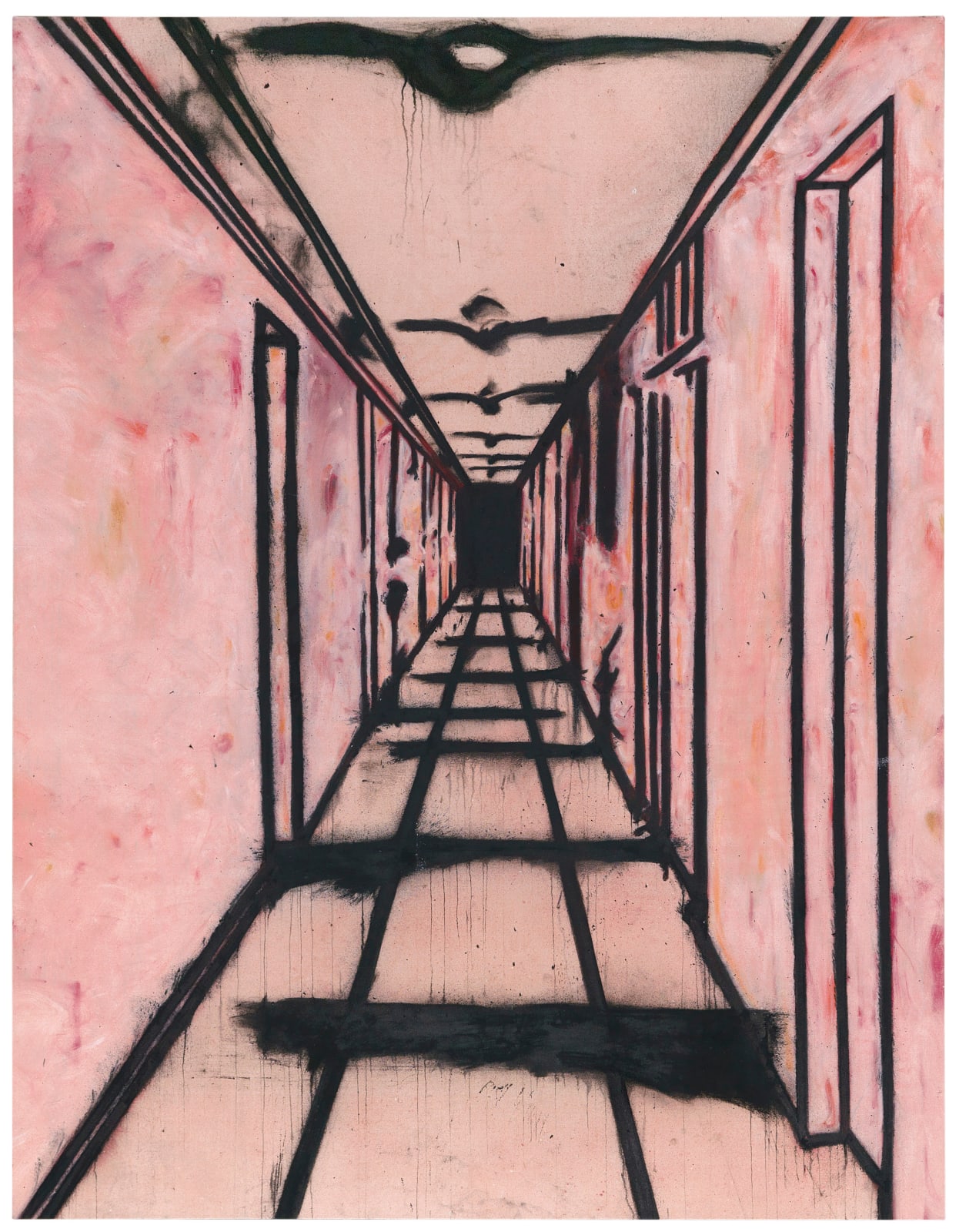
Tony Bevan British, b. 1951
Corridor (PC9710), 1997
Acrylic and charcoal on canvas
268.5 x 208.3 cm; (105 3/4 x 82 1/8 in.)
Copyright The Artist
Tony Bevan’s Corridor series, a central preoccupation throughout the 1990s, epitomises his enduring exploration of the intersection between physical space and the metaphysical resonances of the human psyche. Alongside his...
Tony Bevan’s Corridor series, a central preoccupation throughout the 1990s, epitomises his enduring exploration of the intersection between physical space and the metaphysical resonances of the human psyche. Alongside his celebrated Head portraits, these works articulate a liminal zone between abstraction and figuration, material and immaterial, dreamscape and quotidian reality. Rendered with jagged, lacerated charcoal lines –diagonal, vertical, and horizontal – the Corridor paintings evoke a profound sense of drama, carving receding passageways into the canvas. Typically executed in monochrome hues such as beige or soft pink, the works transform their spatial voids into arenas charged with tension and resonance.
Bevan conceptualises the corridor as a transitory space, a threshold between states of being. As Richard Dyer eloquently observes, “Bevan’s corridors function... within the arena of painting rather than that of film and narrative. Fragmentary, fragile, precarious, and at once open and closed, they act as conduits from one state to another. Like the mythological tunnel of light reported by those who have experienced ‘near-death’ episodes, they act metaphorically as active visual tropes for the possibility of shifting into different perceptual modalities... the viewer enters a psycho-physical space in which the painting acts as a semi-permeable membrane, a ‘leaky’ diaphragm between the physical fact of the universe and the possibility of dreaming while awake.” Dyer situates Bevan’s work within a lineage of cinematic vision, drawing parallels to scenes from Stanley Kubrick’s 2001: A Space Odyssey (1968) and Ken Russell’s Altered States (1980).
The Corridor series is equally informed by Bevan’s engagement with art history and his immediate environment. Richard Cork identifies the dramatic perspectival recession in Tintoretto’s The Finding of the Body of St Mark (1548) as a key influence, specifically the spatial drama generated by the painting’s barrel-vaulted ceiling. Closer to home, the architecture surrounding Bevan’s London studio – its decay, melancholy, and industrial desolation – served as an omnipresent muse. Cork recounts how, “One look through an open window was sufficient to trigger an obsession with the narrow, claustrophobic space he saw stretching away inside.”
The absence of human figures in Bevan’s Corridor works only heightens their eerie presence, anthropomorphising these spaces into sentient, animated beings. Traces of human intervention – cracks in the walls, drips on the floor, the hand-hewn construction of the spaces themselves – imbue the scenes with a palpable psychological charge. Without the physical presence of figures, the corridors resonate with an enduring human imprint, transformed into mnemonic sites of memory and existence.
Mark Livingstone interprets the Corridor series as a manifestation of Bevan’s dialogue with his studio, its confines, and its expanses. These works, Livingstone suggests, literalise the mental interior: the fissures, voids, and crevices of the mind materialised onto canvas. In this light, Bevan’s corridors are not mere architectural spaces but thresholds into the psyche, where the personal and universal coalesce.
Bevan conceptualises the corridor as a transitory space, a threshold between states of being. As Richard Dyer eloquently observes, “Bevan’s corridors function... within the arena of painting rather than that of film and narrative. Fragmentary, fragile, precarious, and at once open and closed, they act as conduits from one state to another. Like the mythological tunnel of light reported by those who have experienced ‘near-death’ episodes, they act metaphorically as active visual tropes for the possibility of shifting into different perceptual modalities... the viewer enters a psycho-physical space in which the painting acts as a semi-permeable membrane, a ‘leaky’ diaphragm between the physical fact of the universe and the possibility of dreaming while awake.” Dyer situates Bevan’s work within a lineage of cinematic vision, drawing parallels to scenes from Stanley Kubrick’s 2001: A Space Odyssey (1968) and Ken Russell’s Altered States (1980).
The Corridor series is equally informed by Bevan’s engagement with art history and his immediate environment. Richard Cork identifies the dramatic perspectival recession in Tintoretto’s The Finding of the Body of St Mark (1548) as a key influence, specifically the spatial drama generated by the painting’s barrel-vaulted ceiling. Closer to home, the architecture surrounding Bevan’s London studio – its decay, melancholy, and industrial desolation – served as an omnipresent muse. Cork recounts how, “One look through an open window was sufficient to trigger an obsession with the narrow, claustrophobic space he saw stretching away inside.”
The absence of human figures in Bevan’s Corridor works only heightens their eerie presence, anthropomorphising these spaces into sentient, animated beings. Traces of human intervention – cracks in the walls, drips on the floor, the hand-hewn construction of the spaces themselves – imbue the scenes with a palpable psychological charge. Without the physical presence of figures, the corridors resonate with an enduring human imprint, transformed into mnemonic sites of memory and existence.
Mark Livingstone interprets the Corridor series as a manifestation of Bevan’s dialogue with his studio, its confines, and its expanses. These works, Livingstone suggests, literalise the mental interior: the fissures, voids, and crevices of the mind materialised onto canvas. In this light, Bevan’s corridors are not mere architectural spaces but thresholds into the psyche, where the personal and universal coalesce.